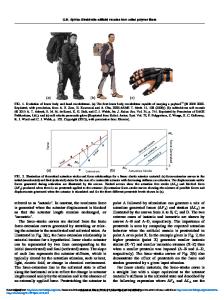High-Performance Polymer Fibers
- PDF / 673,572 Bytes
- 5 Pages / 604.8 x 806.4 pts Page_size
- 12 Downloads / 378 Views
Introduction
Since the pioneering work of Carothers1 which led to the introduction of strong nylon fibers by DuPont in the 1930s, polymer scientists have pursued the development of high-performance fibers to replace natural or metallic products, both to improve mechanical properties and to reduce weight. That development was relatively slow and evenly paced until DuPont again revolutionized the field with the release of Kevlar™, 2 an aromatic polyamide with unprecedented mechanical properties. Since then, the field has literally boomed with new developments, and now organic fibers are available with properties that compete with the best inorganics and are far superior to metal fibers. Strong motivation for the invention of new organic fibers comes from the aerospace industry, which seeks fibers to use in reinforced composite structural materials. Composites bring new advances in stiffness (airplane wings can't bend too much!)3 in weight savings (every kilogram saved in the structure of an airplane saves $120 over its lifetime, and in a spacecraft $10,000)," and in radically new ideas, such as radar-invisibility (stealth)5 and missionadaptive wings (in-flight variable-shape wings).6 Hence, for a variety of specialty applications, otherwise commercially indefensible materials become viable. Molecular Origin of High Performance in Polymers
It may be somewhat counter intuitive to materials scientists unfamiliar with polymers to expect polymer mechanical properties to be greater than in the best metals. The origin of high strength and stiffness in a polymer fiber is the covalent bond, especially when aligned in an ordered array of long chain molecules. Staudinger7 in the early 1930s predicted the age of nearultimate properties in polymers when he sketched the "continuous crystal" model (Figure 1). His model indicated three requirements for high axial modulus and strength: (1) high molecular weight (long) chains in extended form, with few chain end defects; (2) perfect orientation of chains along the axial direction; and (3) perfect lateral packing of the chains. More than 50 years later we are beginning to approach that model from two different directions. Two Classes of High-Performance Polymeric Fibers Extended Chain Flexible Polymers
The oldest class of synthetic polymeric fibers is that of the extended flexible chain
THERMOTROPIC POLYESTER /
P-q
-5
o
" '
o POLY (p-PHENYLENE TEREPHTHALAMIDE)
POLY (p-PHENYLENE BENZOBISOXAZOLE)
Figure 1. Schematic of Staudinger's "continuous crystal" model for polymer fibers.7
polymer, such as nylon or polyethylene (PE). The p o l y m e r r e p e a t unit for polyethylene is shown in Figure 2. Early methods of fiber spinning from either solution or the melt served to orient and extend the polymer chains, but still resulted in a two-phase morphology of alternating ordered (crystalline) and disordered (amorphous) regions along the fiber. The low modulus of the amorphous regions (about 6 GPa) in series with the much higher stiffness of the crystals (about 300 GPa for PE) resul
Data Loading...











